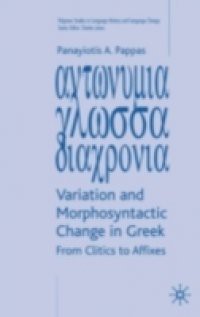The development of weak object pronouns in the history of the Greek language has confounded researchers for decades. This book presents the results of a variationist analysis of the last phase of the change during which these elements exhibited both clitic-like and affix-like behavior. The methodology employs both traditional and innovative ways of analyzing textual evidence, while the statistical tools that are used provide the first accurate description of the pattern of variation during the period of Later Medieval and Early Modern Greek. The analysis reveals a number of linguistic parameters that affect the behavior of the weak object pronouns, and it demonstrates that non-linguistic parameters such as the style of the text and its geographical provenance also influence the pattern of variation. Based on these empirical results several previous proposals are evaluated and shown to fall short of a full explanation. An alternative approach launched from a diachronic perspective is proposed and its implications on our understanding of the nature of language change, the status of clitics in morphology and the role of generalizations in linguistic explanation are discussed.

